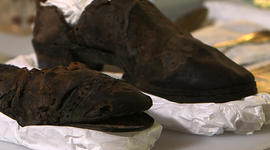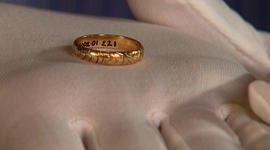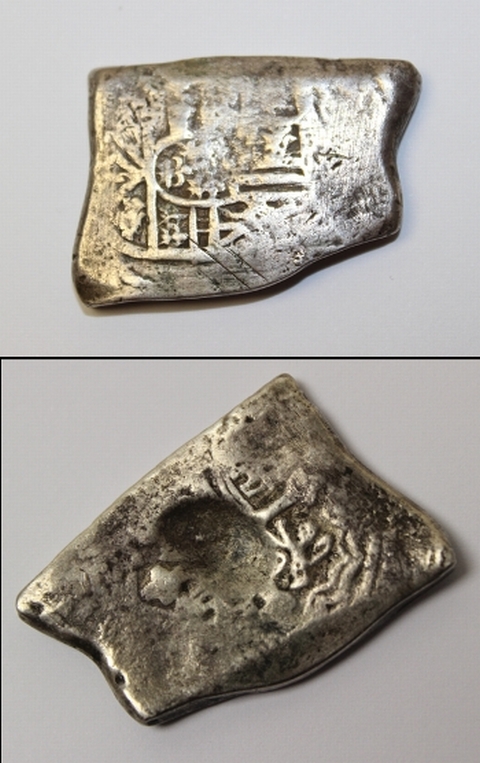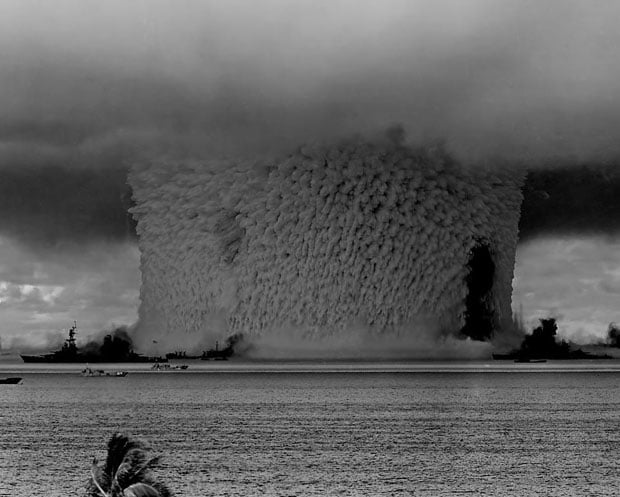HOT NEWS !
Stay informed on the old and most recent significant or spectacular
nautical news and shipwreck discoveries

-
Honoring USS Monitor's fallen heroes
- On 12/03/2013
- In Famous Wrecks
- 0 comments


By David Martin - CBS NewsAmerica is about to pay final respects to two of its fallen heroes more than a century after they lost their lives. But we can't tell you who they were and we may never know.
It is a solemn fact that the remains of Americans killed in conflicts dating back to World War II keep coming home from distant battlefields.
But Thursday was different, as flag draped caskets held unidentified sailors from the Civil War.
"Two human beings buried under there for 140 years or so," explained Joe Hoyt. He was one of the divers who discovered the remains in 240 feet of water off Cape Hatteras, North Carolina, where they had gone down with one of the Navy's most famous ships -- the USS Monitor.
"Arguably more significant than almost any shipwreck certainly in U.S. history," said Hoyt, "and to get down there and actually see it -- there's really nothing else like it."
The hull of the Monitor still lies where it sank, designated a marine sanctuary. But its gun turret -- with the remains still inside -- was raised from the bottom in 2002, and brought to the Mariner's Museum in Newport News, Virginia where Anna Holloway is head curator.
"This is the ship that you read about in 5th grade -- the Monitor and the Merrimack," she said.
The pride of the Union Navy earned its place in history on the day it fought the Confederate ship Merrimack to a draw.
"This was the first battle of iron-clad warships ever in history, and that's really what makes the Battle of Hampton Roads on March 9, 1862 so significant," said Holloway.
But ten months later the prototype for today's iron warships went down in a storm. "A very short life," said Holloway of the Monitor. "But a very monumental one if you think about her impact on modern warships."
When the turret was brought up, pieces of the sailor's lives came with it. A mismatched pair of shoes gave silent testimony to curator David Krop about the ship's final moments.
"If you think about the chaos the night of the sinking," he said, "if there's water coming into the ship, it's dark, you might just grab what's closest to you, put those on in order to get out of the vessel.
-
'Viking sunstone' found in shipwreck
- On 08/03/2013
- In Underwater Archeology
- 0 comments

From BBC NewsA crystal found in a shipwreck could be similar to a sunstone - a mythical navigational aid said to have been used by Viking mariners, scientists believe.
The team from France say the transparent crystal may have been used to locate the Sun even on cloudy days.
This could help to explain how the Vikings were able to navigate across large tracts of the sea - well before the invention of the magnetic compass.
However, a number of academics treat the sunstone theory with scepticism.
The team from the University of Rennes in France say they found the crystal while examining the wreck of a British ship sunk off the island of Alderney - in the English Channel - in 1592.
An oblong crystal the size of a cigarette packet was next to a pair of dividers - suggesting it was part of the navigational equipment.
It has now been shown that it is of Iceland spar - a form of calcite known for its property of diffracting light into two separate rays.
Testing a similar crystal, the scientists proved that by rotation it was possible to find the point where the two beams converge - indicating the direction of the Sun.
-
What lies at the bottom of Lake Michigan
- On 01/03/2013
- 0 comments

By Julia Thiel - Chicago Reader12TH STREET BEACH WRECK, YEAR UNKNOWN
Just south of the Adler Planetarium, an unidentified shipwreck is embedded in the sand. Underwater Archaeological Society of Chicago president John Bell says that it's probably the closest wreck to shore in the area; you can actually walk to it.
Shoreline erosion caused by the construction of the planetarium in 1925 exposed the hull of the schooner, which is an estimated 140 feet long.
The stern end of the ship has been paved over, but Bell says that "on a good day, you can see the ribs."
LADY ELGIN, 1860
The deadliest shipwreck in the Great Lakes until the Eastland disaster—and still the worst open-water disaster on Lake Michigan—was the sinking of this 252-foot passenger steamer.
In an early-morning storm a schooner rammed the side of the larger steamship at full speed, ripping a hole it in.
The schooner suffered some damage but made it back to Chicago, while the Lady Elgin quickly broke in half and sank.
Many of the passengers floated toward the coastline on pieces of the deck, only to be drowned in the surf near shore. Of the nearly 400 passengers aboard, more than 300 died.
The remains of the ship were discovered in 1989 by shipwreck hunter Harry Zych, who immediately claimed ownership of them.
Nearly 20 years of searching was followed by a decade of litigation, and though shipwrecks are usually the property of the state, Zych eventually won the legal battle.
He's found artifacts including pre-Civil War muskets and swords, china plates and spoons engraved with the words "Lady Elgin," a three-foot-long steam whistle, and a chandelier.
-
Hollandia shipwrecked 'pirate coin' stolen
- On 01/03/2013
- In Scams, Thefts
- 0 comments

From BBC News
A distinctive Spanish silver coin, recovered from the shipwreck of the Hollandia which sank in 1743, has been stolen from a house in Hertfordshire.The eight reales coin, minted in 1741 and hung from a chain, was taken in a burglary at a house at Braughing, near Ware, on Friday, said police.
A spokesman from the British Museum said the coins, known as pillar dollars, were "historically important".
Police have appealed for anyone with information to contact them.
The coin, minted in Mexico, sunk to the seabed when the Hollandia, carrying a cargo of silver from Amsterdam to the Far East, sank during her maiden voyage off the coast of the Isle of Scilly.
Tom Hockenhull, curator of modern money at the British Museum, said: "Historically these coins are quite important as they were some of the first trade coins - the model for the US dollar essentially.
-
Australian Billionaire: “Titanic II” Will NOT Be Unsinkable
- On 28/02/2013
- 0 comments

By Jonathan Allen - gCaptain/Reuters
Australian mining entrepreneur Clive Palmer on Tuesday unveiled blueprints for Titanic II, a modern replica of the doomed ocean liner, although he stopped short of calling the vessel unsinkable.
The ship will largely recreate the design and decor of the fabled original, with some modifications to keep it in line with current safety rules and shipbuilding practices, and the addition of some modern comforts such as air conditioning, Palmer said at a press conference in New York.
The three passenger classes, however, will be prevented from mingling, as in 1912, Palmer said.
“I’m not too superstitious,” Palmer said when asked whether recreating a ship best known for sinking was tempting fate.
White Star Line, the operator of the original ship, had said the Titanic was designed to be unsinkable.
Some 1,500 people died on Titanic’s maiden voyage in 1912 from Southampton to New York after the ship collided with an iceberg in the North Atlantic.
Palmer, who created the company Blue Star Line last year, declined to make a similar boast.
“Anything will sink if you put a hole in it,” Palmer said.
“I think it would be very cavalier to say it.”
Unlike the original, Titanic II will have more than enough space in its lifeboats for every person on board and will have additional escape staircases.
Markku Kanerva, sales director at Deltamarin, the Finnish company designing the ship, said it would be the “safest cruise ship in the world.”
Palmer declined to answer questions about the project’s cost.
Although the Titanic was the world’s largest ship in her time, she would be smaller than many of today’s modern cruise ships.
-
Oil threat from shipwrecks
- On 27/02/2013
- In Miscellaneous
- 0 comments
By Chad Oliver - NBC2
An NBC2 Investigation examined the fragile future of deep sea shipwrecks which some have called "ticking time bombs."
They are relics of the past but posing potential problems for the future.
One ship in particular sits 75 miles from Southwest Florida and is now on the dederal government's radar. It's an oil cargo ship named the Joseph M. Cudahy, which could cause a mess for the environment and for tourism.
Records show the Cudahy had nearly 80,000 barrels of oil on board when a German U-boat blasted it with a torpedo during World War II.
Even though the ship sank in 1942, divers say oil still leaks into the water.
In 2010, Congress allocated $1-million for the National Oceanic Atmospheric Administration (NOAA) to form a database of shipwrecks and assess their threat.
It's called "Remediation of Underwater Legacy Environmental Threats – referred to as "RULET."
We were was given advance results of the assessment ahead of the national report coming out later this month.
Out of 20,000 ship wrecks off the coast of the U.S., NOAA determined about one hundred pose a substantial pollution threat.
Fewer, only six, are considered high priority for a most-probable discharge of oil. One of those ships is the Cudahy.
It's a ship Michael Barnette, from the Association of Underwater Explorers, knows well.
"One of the easiest ways to find the wreck when you're in the vicinity, especially on a calm day - you'll see a slick on the water," said Barnette. "You actually smell it before you get there."
Barnette is a respected diver who has written three books on Florida shipwrecks. He is a marine biologist who spends his free-time exploring underwater.
"There are still plenty of wrecks to be found," added Barnette.
The St. Pete native has identified or helped identify more than 50 shipwrecks worldwide, including the Cudyhy six years ago.
He said what makes diving intriguing is "piecing together in your mind what happened."
-
Pieces of eight from West Cornwall shipwreck sold at auction
- On 26/02/2013
- In Auction News
- 0 comments

From Falmouth Packet
Coins recovered from a West Cornwall shipwreck that still inspire visions of pirates and buried treasure have sold at auction.
The 17th Century Cob and piece of eight were recovered from the wreck of HMS Association, lost at sea in 1707.
Sold by Hanson's Auctioneers in Derbyshire the coins were found after the ship, which launched from Portsmouth Dockyard in 1697 and fought at capture of Gibraltar, was dredged up 300 years later in 1967.
One was a 17th century ‘COB,’ a Spanish currency.
Unusually shaped, this coin details the history of Spain, as this currency was cut crudely into shapes of an accurate weight, in preparation for its melting down and using in jewellery.
Also uncovered from the wreck was an example of the infamous pieces of eight. As the world’s first global currency these were used across the vast Spanish Empire.
-
World’s first underwater nuclear explosion
- On 24/02/2013
- In Dangerous Places for Shipping
- 0 comments

By Michael Zhang - Peta Pixel
In in 1946, the United States conducted a series of nuclear weapon tests at Bikini Atoll in what’s known as Operation Crossroads.
A total of two bombs were detonated to test the effects nuclear blasts had on naval warships.
The second, named Baker, was the world’s first nuke to be detonated underwater.
Due to the unique properties of underwater explosions, the Baker test produced a number of unique photographs that the world had never seen before.
Read and see more...